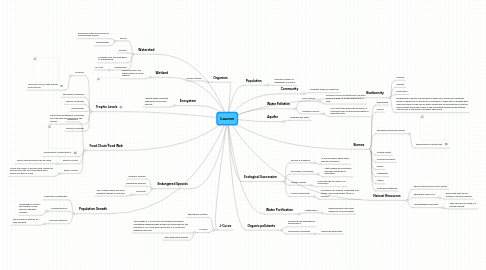
1. Organism
1.1. Living Creature
2. Ecosystem
2.1. Habitat where different organisms survive and interact.
3. Trophic Levels
3.1. Producer
3.1.1. They get 100% of their energy from the sun.
3.2. Secondary Consumer
3.3. Tertiary Consumer
3.4. Decomposer
3.5. Each time something is consumed you only gain one percent of the energy.
3.6. primary consumer
4. Food Chain/Food Web
4.1. Organisms
4.2. Arrows point to what eats it.
4.3. Abiotic Factors
4.3.1. Never living and never will be living.
4.4. Biotic Factors
4.4.1. Living, was living, or will be living. These can even be just part of a living thing like a broken off part of a leaf.
5. Endangered Species
5.1. Indicator Species
5.2. Threatened Species
5.3. hot spots
5.3.1. This is where there are many different species in one area.
6. Population Growth
6.1. Population Growth rate
6.2. Limiting Factors
6.2.1. These help to control the number of one species. Example: Disease
6.3. Carrying Capacity
6.3.1. The number of species an area can hold.
7. J-Curve
7.1. Exponential Growth
7.2. S-Curve
7.2.1. This is when a J-Curve has a turning point because something happened that leveled off the growth of the population. It is not a direct point but is a curve that happens over time.
7.2.2. Zero population growth
8. Watershed
8.1. Runoff
8.1.1. Runoff will often come from an impermeable surface.
8.1.2. Impermeable
8.2. Erosion
8.3. All water from one area goes to a watershed.
8.4. Urbanization
8.4.1. In a city
9. Wetland
9.1. This is good for our enviornment for many reasons.
10. Population
10.1. The total number of inhabitants in a place.
11. Community
11.1. Different types of organisms.
12. Biomes
12.1. Rainforests
12.2. Tundra
12.3. Temperate deciduous forest
12.3.1. Pennsylvania is mostly this.
12.4. Tropical forest
12.5. Coniferous forests
12.6. Desert
12.7. Freshwater
12.8. Marine
12.9. Grassland/Savannah
13. Biodiversity
13.1. Genetic
13.2. Species
13.3. Ecosystem
13.4. Biodiversity is bad to lose because it helps us to have many different types of medincine or nutrients. For example if there were a disease that killed one type of tree and an entire forest was of that particular tree the whole forest would die off but if the forest was biodiverse the disease may kill only a few trees or possibly even none.
14. Ecological Succession
14.1. Primary Succession
14.1.1. In a place where there never was an ecosystem.
14.2. Secondary Succession
14.2.1. Starts where an ecosystem has been disturbed or destroyed.
14.3. Pioneer species
14.3.1. First plant/life to come to an ecosystem.
14.4. Climax Community
14.4.1. "branched off" species, originated from others. They grow slowly. (End of Process)
15. Water Pollution
15.1. Point Source
15.1.1. Pollution can be pin pointed to one area such as a drain or a boat leaking into a lake.
15.2. Nonpoint Source
15.2.1. You cannot tell where the pollution is comming from such as animal waste or cigarette butts.
16. Water Purification
16.1. Desalination
16.1.1. Removing salts and other chemicals from the water.
17. Aquifer
17.1. Underground water.
18. Natural Resources
18.1. Resources that come from nature.
18.2. Renewable resources
18.2.1. Resources that can be reused in a human lifetime.
18.3. Nonrenewable resources
18.3.1. They cannot be reused in a human lifetime.
19. Organic pollutants
19.1. Pollutants that degrade the enviornment
19.2. Nonorganic pollutants
19.2.1. Things like pesticides.
